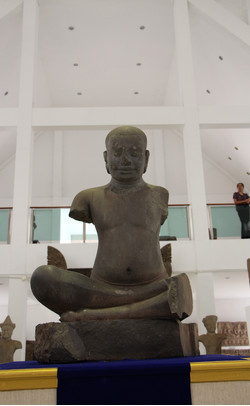ค้นหางานศิลปกรรม
ฐานข้อมูลศิลปกรรมในเอเชียตะวันออกเฉียงใต้
พระเจ้าชัยวรมันที่ 7
คำสำคัญ : ปราสาทพิมาย, พิพิธภัณฑสถานแห่งชาติ พิมาย, พระเจ้าชัยวรมันที่ 7
| ชื่อหลัก | พิพิธภัณฑสถานแห่งชาติ พิมาย |
|---|---|
| ประเภทงานศิลปะ | ประติมากรรม |
| ตำบล | ในเมือง |
| อำเภอ | พิมาย |
| จังหวัด | นครราชสีมา |
| ภาค | ภาคตะวันออกเฉียงเหนือ |
| ประเทศ | ไทย |
| พิกัดภูมิศาสตร์ ค่าองศาทศนิยม | Lat : 15.224812 Long : 102.494452 |
| พิกัดภูมิศาสตร์ พิกัดกริด | Zone : 47 P Hemisphere : N E : 230843.9 N : 1684737.63 |
| ตำแหน่งงานศิลปะ | ภายในห้องจัดแสดงพิพิธภัณฑสถานแห่งชาติ พิมาย |
| ประวัติการสร้าง | ไม่ปรากฏหลักฐานลายลักษณ์อักษรที่เกี่ยวข้องกับประวัติการสร้างประติมากรรมองค์นี้โดยตรง แต่เชื่อว่าสร้างขึ้นในสมัยพระเจ้าชัยวรมันที่ 7 หรือพุทธศตวรรษที่ 18 เพื่อเป็นรูปฉลองพระองค์ของท่านเอง ทั้งนี้มีรูปแบบที่เทียบได้กับประติมากรรมพระเจ้าชัยวรมันที่ 7 ที่พบในประเทศกัมพูชาและลาว |
|---|---|
| กระบวนการสร้าง/ผลิต | หินทรายแกะสลัก |
| ประวัติการอนุรักษ์ | ค้นพบภายในปรางค์พรหมทัตภายในปราสาทพิมาย อำเภอพิมาย จังหวัดนครราชสีมา |
| ขนาด | 1.42 เมตร |
| ลักษณะทางศิลปกรรม | ประติมากรรมฉลองพระองค์พระเจ้าชัยวรมันที่ 7 มีสภาพชำรุดบางส่วน พระกรทั้งสองข้างและพระชานุซ้ายหักหายไป พระพักตร์เหลี่ยม พระเนตรปิด แย้มพระโอษฐ์เล็กน้อย พระเกศายาวเกล้าเป็นมวย พระวรกายท้วม ช่วงบนไม่ทรงอาภรณ์ใดๆ ช่วงล่างทรงสมพตสั้น นั่งอยู่ในอิริยาบถขัดสมาธิ พระหัตถ์ที่หักหายไม่ทราบว่าทำท่าทางใด แต่บางท่านสันนิษฐานว่าประนมกรไว้ เพราะหากทำท่าสมาธิหรือวางบนพระเพลาจำต้องเห็นร่องรอยของฝ่าพระหัตถ์ที่ติดอยู่กับพระเพลา |
| ข้อมูลที่สำคัญทางวิชาการ | ประติมากรรมนี้เชื่อว่าเป็นรูปฉลองพระองค์ของพระเจ้าชัยวรมันที่ 7 ค้นพบที่ปราสาทหินพิมาย อำเภอพิมาย จังหวัดนครราชสีมา นับเป็นรูปฉลองพระองค์ของกษัตริย์ที่เก่าแก่ที่สุดในดินแดนไทย ทั้งยังอยู่ในสภาสมบูรณ์มาก ประติมากรรมพระเจ้าชัยวรมันที่ 7 นี้สะท้อนให้เห็นว่าในรัชสมัยของพระองค์ดินแดนแถบนี้คงอยู่ภายใต้พระราชอำนาจของพระองค์ |
| ยุค | ประวัติศาสตร์ |
| สมัย/รูปแบบศิลปะ | ลพบุรี |
| อายุ | พุทธศตวรรษที่ 18 รัชกาลพระเจ้าชัยวรมันที่ 7 |
| ศาสนา/ความเชื่อที่เกี่ยวข้อง | ความเชื่อท้องถิ่น |
| ตำนานที่เกี่ยวข้อง | ชาวบ้านเชื่อกันว่าประติมากรรมนี้เป็นรูปท้าวพรหมทัต เจ้าเมืองพิมายในตำนานท้องถิ่นเรื่อง ปาจิตอรพิม |
| งานศิลปะที่เกี่ยวข้อง | ประติมากรรมฉลองพระองค์ของพระเจ้าชัยวรมันที่ 7 น่าจะอยู่ในฐานะของรูปเคารพด้วย โดยอาจเกี่ยวข้องกับประเพณีหนึ่งของชาวเขมรโบราณที่ยกสถานภาพของกษัตริย์และพระวงศ์ขึ้นเป็นเทพเจ้าในศาสนาพราหมณ์ เช่น พระศิวะ พระวิษณุ แต่ถ้านับถือศาสนาพุทธก็ยกย่องสถานภาพให้เป็นพระพุทธเจ้าหรือพระโพธิสัตว์ รูปฉลองพระองค์พระเจ้าชัยวรมันที่ 7 อาจอยู่ในฐานะรูปเคารพเพราะถือกันว่าพระองค์เสมือนเป็นทิพยบุคคลในร่างมนุษย์ อันเป็นความเชื่อที่เกี่ยวเนื่องกันกับการยกสถานภาพบุคคลให้เสมือนเทพเจ้าหรือพระพุทธเจ้านั่นเอง |
| รูปแบบลิขสิทธิ์ | Attribution-NonCommercial-NoDerivs (CC BY-NC-ND) |
|---|---|
| เจ้าของสิทธิ์ | ศูนย์มานุษยวิทยาสิรินธร (องค์การมหาชน) |
| วันที่จัดทำข้อมูล | 2016-09-30 |
| ผู้จัดทำข้อมูล | รุ่งโรจน์ ธรรมรุ่งเรือง |
| บรรณานุกรม | สุภัทรดิศ ดิศกุล, หม่อมเจ้า. (เรียบเรียง) ประติมากรรมขอม. กรุงเทพฯ : กรุงสยามการพิมพ์, 2515. สุภัทรดิศ ดิศกุล, หม่อมเจ้า. ศิลปะสมัยลพบุรี. กรุงเทพฯ : มหาวิทาลัยศิลปากร, 2547. สุริยวุฒิ สุขสวัสดิ์, หม่อมราชวงศ์. “รูปพระเจ้าชัยวรมันที่ 7 จากเมืองซายฟองในสาธารณรัฐประชาธิปไตยประชาชนลาว” ศิลปวัฒนธรรม ปีที่ 9, ฉบับที่ 1 (พฤศจิกายน 2530), หน้า 60-70. |


